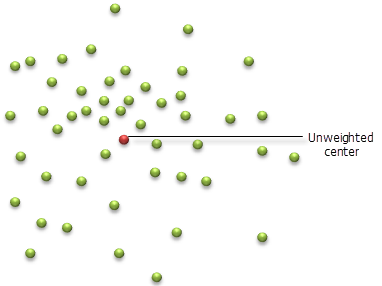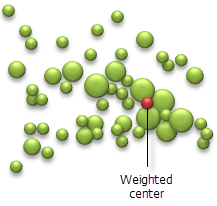Should you use weights when measuring the distribution of features?
If you want to measure characteristics of feature locations, run your analysis without a Weight Field. The unweighted analysis is often used for incidents or events that occur at a particular place and time. Examples would be analysis of crime events or disease incidents.

When some features are more important than others, you can use the Weight Field to reflect those feature differences. Suppose you want to find the best location for a new grocery store warehouse. You want a location that is central, but you also want to find a location that is most convenient to stores with the highest sales volumes. In this case, an attribute reflecting sales volumes (e.g., store revenues or perhaps a proxy like store size) can be used as a weight in statistical calculations; stores with larger sales volumes will have a stronger influence on statistical results than stores with smaller sales volumes. In the illustration below, the larger points have larger sales volumes.

Weighted analysis is common for analyses of stationary features, such as stores or pollution monitoring stations. Unlike incidents or events (such as crime), the distribution of stationary features is usually predetermined, since they have been placed in their location for a reason. Consequently, performing an unweighted analysis that only looks at fixed feature locations, may not be very meaningful. Measuring the spatial characteristics of features when they are weighted by an attribute, however, can be very useful. For example, you might use the location of pollution monitoring stations and the readings of ozone at each for a given period to calculate the center of highest ozone concentration.
Specifying a weight
Weights are numeric attributes associated with the features in your dataset. The higher the numeric value, the greater the weight for that feature. For example, if you wanted to find the most accessible location to hold a seminar for workers in the financial sector, you could calculate the weighted center of businesses using the number of employees as the Weight Field. Or, an environmental analyst could compute the weighted mean center for different pollutants using air pollution readings from monitoring stations. The information might be useful for comparing pollutant centers to potential sources such as factories or truck depots.